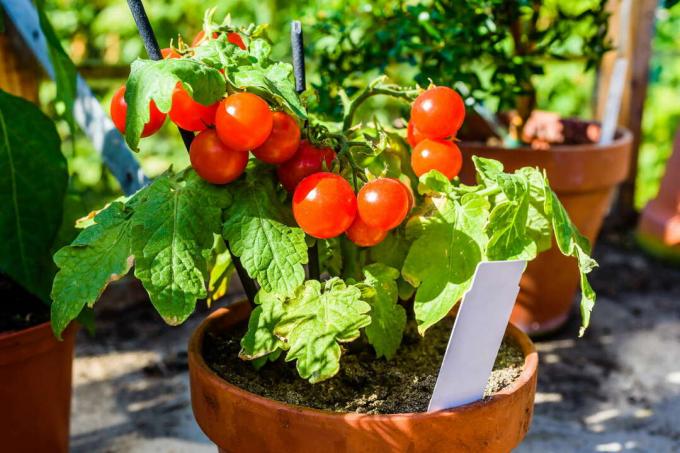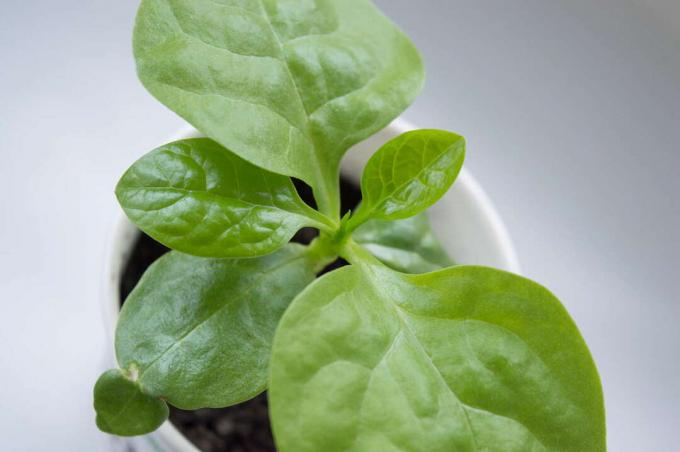There is space in the smallest hut - even for a vegetable patch. We show you ten plants that also thrive in pots without any problems and deliver a delicious harvest.

Every hobby gardener's dream is to have their own small vegetable patch: Fresh, healthy food that accompanies you from the patch to the cooking pot. And having your own vegetable patch is fun too. But what if the garden is bursting at the seams or you only have a small apartment available? That's no reason to stick your head in the sand. Because these ten types of vegetables can also be grown wonderfully in pots - and they always find a place somewhere.
contents
- 10. Growing tomatoes in pots
- 9. Grow lettuce in a pot
- 8. Growing carrots in a pot
- 7. Growing radishes in pots
- 6. Grow chillies in pots
- 5. Growing beans in pots
- 4. Growing spinach in a pot
- 3. Growing beets in pots
- 2. Growing onions in pots
- 1. Grow potatoes in pots
We present our ten favorite types of vegetables for pot culture, which also find their place in the smallest garden or on the balcony and terrace. Because if you want to grow your own vegetables, you can do so with these varieties without a vegetable patch.
10. Growing tomatoes in pots
Tomatoes are probably one of the most popular plants in German gardens. But the tomato doesn't cut a bad figure in the pot either. Not only small balcony varieties are suitable for cultivation, but also larger ones tomato varieties such as bush tomatoes are suitable, but must be supported with a so-called tomato column made of wire mesh. Plant sticks are not very suitable for pots because they do not find enough support in the ground. A pot size between seven and twelve liters of soil (depending on the variety) is ideal. However, it is particularly important that the containers have good water drainage so that waterlogging does not occur. The tomatoes find an ideal place on a balcony, where they are in partial shade. Otherwise, they require the same care as a regular tomato in the garden. More to Fertilizing, watering and mulching tomatoes you can read here.

9. Grow lettuce in a pot
The salad is also a true classic in the vegetable patch. Regardless of whether Lamb's lettuce or arugula, all varieties have something in common: tasty, fresh and not too demanding, but they can also be grown perfectly in pots or flower boxes. Large, flat bowls with vegetable soil, into which the lettuce seeds can be sown directly, are ideal for growing lettuce. Now the salad just needs a nice, bright spot in the house or on the balcony and a sip of water every now and then. After four to six weeks, the work is bearing fruit and the first leaves can be harvested. And growing in pots has an added benefit: gluttons snails and bad weather certainly won't spoil your harvest.

8. Growing carrots in a pot
carrots are not only rabbit food - the orange roots also taste good to humans cooked or as a snack in between. But can you grow carrots in a pot? Yes, you just need the right one. Since the carrot is a root vegetable and therefore grows deep, the pot should also be particularly high (or deep). With special mini carrots, a normal flower pot can suffice, with others carrot varieties but it should be at least 20 cm, but preferably 30 cm high. Otherwise, the carrots in the pot are quite undemanding: due to the nutrients in the potting soil they hardly need to be fertilized, regular watering and a protected, bright spot will take care of that Rest.

Tip: All the necessary materials for sowing carrots can be found in our Plantura vegetable growing set. In addition to carrot seeds, the vegetable set also contains seeds for four other sweet and aromatic vegetables.
7. Growing radishes in pots
Crunchy, spicy, different - radish should not be missing from any good raw food platter. You shouldn't be without them in your own four walls either, because the small radish is very easy to grow in pots. Almost all radish varieties are suitable for pot cultivation: They only need a place in the sun, but they usually also tolerate partial shade. Otherwise, they should be watered regularly, as the soil in the pot dries out faster than in the bed and the radish likes that just as little as waterlogging. It is best to always have some residual moisture in the soil, but without it becoming too wet. After just one month, the time has come and the pink tubers from the pot can be harvested.

6. Grow chillies in pots
A tip for everyone who likes it fiery: Also the exotic one chili can be grown in a pot without burning your fingers on this venture. Light and the right temperature are particularly important for the chili. Temperatures around 20°C are common in their homeland, which is why a place under a sunny window in a warm apartment or on the south-facing balcony is ideal for the plant. Here the plant should ideally receive up to 14 hours of light a day. The right size of the flower pot is also important: a diameter of at least 20 cm is dependent on chilli variety recommended so that the soil in the bucket does not dry out too quickly. Now the chili should be regularly washed with water from the rain barrel (calcareous water from the tap does not tolerate them well) and you have your own little chilli plantation in the House.

5. Growing beans in pots
French, pole or fire beans? The selection of types of beans is huge and almost all of them can be planted in one pot. Bush beans need a pot with at least 20 x 20 cm (diameter x height). Pole beans, on the other hand, should be placed in a larger and, above all, heavy pot because of their height. Otherwise there is a risk that the plants will simply tip over. Of course, like their siblings in the garden bed, the beans should be given a climbing aid so that they don't lie flat on the ground. Otherwise, the beans only need a warm place and should be watered and fertilized regularly.

4. Growing spinach in a pot
Not only is Popeye's favorite food super healthy, it's also easy to grow in a pot. The plant and its various varieties do not make any special demands: if you only want to harvest the young leaves, any container with a depth of 10 cm is suitable. However, the larger the plant is to be, the deeper the appropriate pot should be. Now he needs spinach a suitable place. Four hours of sunshine a day is enough for the plant. Spinach, on the other hand, does not like hot temperatures at all, nor does it like too little water: This makes its leaves bitter. Therefore, make sure to water the spinach regularly without waterlogging. He will thank you with delicious leaves.

3. Growing beets in pots
Even if Beetroot Often seen as old-fashioned and unfashionable, the vegetables have their very own charm. It is not for nothing that the red tuber has experienced an upswing as a healthy vegetable trend in recent years. Beetroot can also be grown in pots without any problems. With her (like with spinach), the pot size depends on the time of harvest. If the tubers are harvested young, i.e. about the size of a radish, a normal vegetable bucket is sufficient. However, if the plant is to mature, containers with a depth of 30, preferably 40 cm are a must. Otherwise, the beetroot is quite easy to care for. Regular watering and a little fertilizer will not harm it either.

2. Growing onions in pots
the onion is not only perfect for the cooking but also for the flower pot. The plant is ideal for starting your own vegetable garden in pot form. It thrives in almost any container (but a depth of 15 cm is ideal) and requires little care. If you use a good universal soil, the plant does not even need to be fertilized. Regular watering is a must. If you are particularly environmentally conscious or just want to save something, you can simply use kitchen waste instead of seeds. A new plant can easily be grown from a leftover piece of onion.

1. Grow potatoes in pots
the potato goes perfectly with German cuisine and remains a well-known favourite. But potatoes belong in the field and not in the apartment? Wrong thought! Potatoes are also great to grow in pots and almost any variety is suitable. A sufficiently large pot is important so that the delicious tubers have enough space: you should treat your potatoes to at least 20 litres. Otherwise is potato care the same as with a potato plant in the bed. Regular watering, so that the soil never dries out completely, but also prevents waterlogging, is just as important as a little organic fertilizer. If the potatoes are ripe after a hundred days, they can already be harvested. Our insider tip: With a homemade potato pot, you can harvest the potatoes as needed without covering your home with soil.

Tip: Our peat-free Plantura organic tomato & vegetable soil is ideal for growing vegetables in pots. It optimally supplies your vegetables with all the nutrients they need for a rich and aromatic harvest.
If you don't have enough space for vegetables in the pot yourself, you can find our article on the subject here regrowing – so you can even let leftover vegetables grow on the windowsill. And if you want to add some fruit to your vegetables, we'll put them here 10 fruits for growing in the pot in front.



